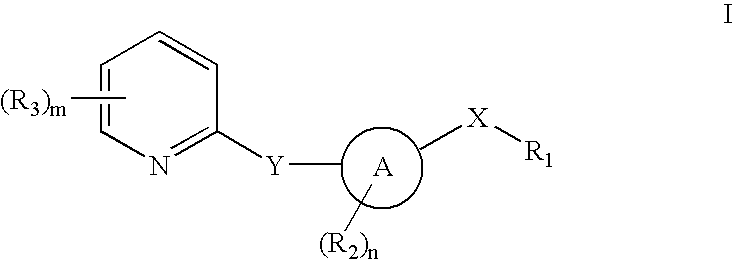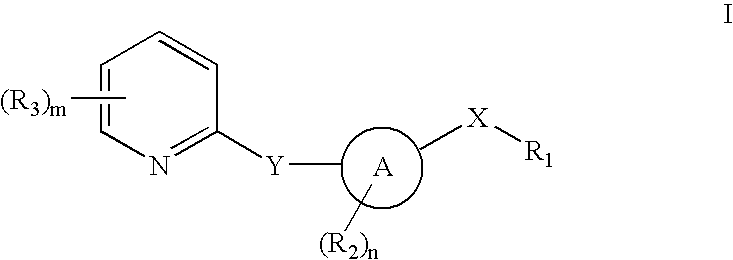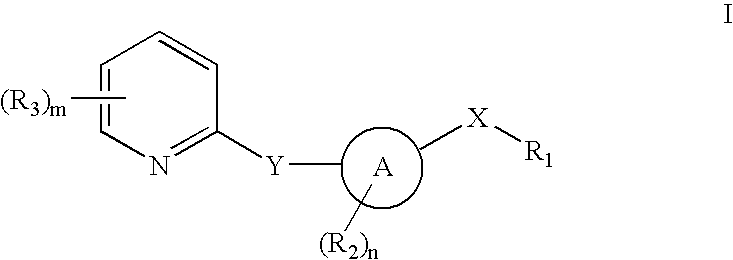Pyridyl inhibitors of hedgehog signalling
a technology of pyridyl compounds and hedgehogs, which is applied in the field of organic compounds, can solve the problems that the exact mechanism by which ptc controls smo activity has yet to be clarified, and achieve the effect of inhibiting hedgehog signaling
- Summary
- Abstract
- Description
- Claims
- Application Information
AI Technical Summary
Benefits of technology
Problems solved by technology
Method used
Image
Examples
example 1
General Procedure
[0115] Compounds of examples 2-51 were prepared according to the following general procedures.
A: Suzuki Coupling Procedure
[0116]
[0117] 2 M aq. Potassium carbonate (5.0 eq) and 4:1 toluene:ethanol mixture (2.5 mL) were added to a microwave vial charged with the appropriate boronate ester (2.6 eq), aryl halide (0.35 mmol, 1.0 eq), and Pd(PPh3)4 (0.04 eq). The vial was sealed and heated with stirring in the microwave to 160° C. for ten minutes. The solution was poured onto 2 M aq. Sodium hydroxide (20 mL), extracted with ethyl acetate (2×20 mL), dried (MgSO4), and concentrated. Purification of the crude product by chromatography on silica gel (conditions given below) afforded the desired product.
B: Negishi Coupling Procedure
[0118]
[0119] Aryl zinc bromide (0.5 M in THF, 2.5 eq) was added to an oven-dried microwave vial charged with the appropriate aryl halide (1.0 eq) and Pd(PPh3)4 (0.04 eq). The vial was sealed and heated with stirring in the microwave to 140° C. ...
example 2
6-(2-morpholinoethylamino)-N-(4-chloro-3-(pyridin-2-yl)phenyl)pyridine-3-carboxamide
[0163]
[0164] Procedure F was performed using N-(4-chloro-3-(pyridin-2-yl)phenyl)-6-chloro-3-carboxamide (50 mg) and 2-morpholinoethylamine in butanol (0.5 mL). The crude reaction was purified by reverse phase HPLC to yield 6-(2-morpholinoethylamino)-N-(4-chloro-3-(pyridin-2-yl)phenyl)pyridine-3-carboxamide as a white solid. MS (Q1) 438.3 (M)+.
example 3
N,N-(4-Chloro-3-(pyridin-2-yl)phenyl)-bis[6-(trifluoromethyl)-2-methylpyridine-3]-carboxamide
[0165]
[0166] Procedure B was performed with 2-pyridylzinc bromide (4 mL, 2.0 mmol, 0.5 M in THF) and 3-bromo-4-chloro-nitrobenzene (236 mg, 1.0 mmol). Purified by chromatography on silica gel (10% ethyl acetate / hexanes) to yield 2-(2-chloro-5-nitrophenyl)pyridine as a light yellow solid.
[0167] Procedure C was performed with 2-(2-chloro-5-nitrophenyl)pyridine (122 mg, 0.52 mmol) to yield 4-chloro-3-(pyridin-2-yl)aniline as a light yellow solid, which was used without further purification.
[0168] Procedure D was performed using 4-chloro-3-(pyridin-2-yl)aniline (40 mg, 0.2 mmol). The crude residue was purified by silica gel chromatography (15-60% ethyl acetate / hexanes) to yield N,N-(4-Chloro-3-(pyridin-2-yl)phenyl)-bis[6-(trifluoromethyl)-2-methylpyridine-3]-carboxamide as an oily residue: TLC Rf=0.42 (35% ethyl acetate / hexanes); 1H NMR (CDCl3, 400 MHz) δ 8.72 (m, 1H), 7.84 (d, 2H0, 7.77 (dd,...
PUM
| Property | Measurement | Unit |
|---|---|---|
| temperatures | aaaaa | aaaaa |
| pH | aaaaa | aaaaa |
| pH | aaaaa | aaaaa |
Abstract
Description
Claims
Application Information
 Login to View More
Login to View More - R&D
- Intellectual Property
- Life Sciences
- Materials
- Tech Scout
- Unparalleled Data Quality
- Higher Quality Content
- 60% Fewer Hallucinations
Browse by: Latest US Patents, China's latest patents, Technical Efficacy Thesaurus, Application Domain, Technology Topic, Popular Technical Reports.
© 2025 PatSnap. All rights reserved.Legal|Privacy policy|Modern Slavery Act Transparency Statement|Sitemap|About US| Contact US: help@patsnap.com



